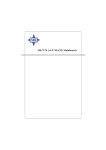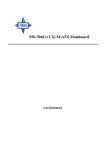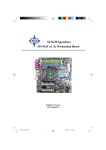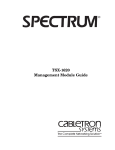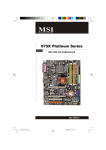Download Medion Printer Instruction manual
Transcript
945P Series MS-7204 (v1.X mBTX Mainboard) i Manual Rev: 1.0 Release Date: October 2005 FCC-B Radio Frequency Interference Statement This equipment has been tested and found to comply with the limits for a class B digital device, pursuant to part 15 of the FCC rules. These limits are designed to provide reasonable protection against harmful interference when the equipment is operated in a commercial environment. This equipment generates, uses and can radiate radio frequency energy and, if not installed and used in accordance with the instruction manual, may cause harmful interference to radio communications. Operation of this equipment in a residential area is likely to cause harmful interference, in which case the user will be required to correct the interference at his own expense. Notice 1 The changes or modifications not expressly approved by the party responsible for compliance could void the user’s authority to operate the equipment. Notice 2 Shielded interface cables and A.C. power cord, if any, must be used in order to comply with the emission limits. VOIR LA NOTICE D’INSTALLATION AVANT DE RACCORDER AU RESEAU. Micro-Star International MS-7204 This device complies with Part 15 of the FCC Rules. Operation is subject to the following two conditions: (1) this device may not cause harmful interference, and (2) this device must accept any interference received, including interference that may cause undesired operation ii Copyright Notice T he material in this document is the intellec tual property of M ICRO-STAR INTERNATIONAL. W e take every care in the preparation of this document, but no guarantee is given as to the correctness of its contents. Our products are under continual improvement and we reserve the right to make changes without notice. Trademarks All trademarks are the properties of their respective owners. AMD, Athlon™, Athlon™ XP, Thoroughbred™, and Duron™ are registered trademarks of AMD Corporation. Intel® and Pentium® are registered trademarks of Intel Corporation. PS/2 and OS ® /2 are registered trademarks of International Business Machines Corporation. Microsoft is a registered trademark of Microsoft Corporation. W indows ® 98/2000/NT/ XP are registered trademarks of Microsoft Corporation. NVIDIA, the NVIDIA logo, DualNet, and nForce are registered trademarks or trademarks of NVIDIA Corporation in the United States and/or other countries. Netware® is a registered trademark of Novell, Inc. Award® is a registered trademark of Phoenix Technologies Ltd. AMI® is a registered trademark of American Megatrends Inc. Kensington and MicroSaver are registered trademarks of the Kensington Technology Group. PCMCIA and CardBus are registered trademarks of the Personal Computer Memory Card International Association. Technical Support If a problem arises with your system and no solution can be obtained from the user’s manual, please contact your place of purchase or local distributor. Alternatively, please try the following help resources for further guidance. † Visit the MSI homepage & FAQ site for technical guide, BIOS updates, driver updates, and other information: http://www.msi.com.tw & http://www.msi. com.tw/program/service/faq/faq/esc_faq_list.php † Contact our technical staff at: [email protected] Revision History Revision V1.0 Revision History First release for PCB 1.X with Intel 945P & ICH7/ICH7R iii Date October 2005 Safety Instructions 1. 2. 3. 4. 5. Always read the safety instructions carefully. Keep this User’s Manual for future reference. Keep this equipment away from humidity. Lay this equipment on a reliable flat surface before setting it up. The openings on the enclosure are for air convection hence protects the equipment from overheating. Do not cover the openings. 6. Make sure the voltage of the power source and adjust properly 110/220V before connecting the equipment to the power inlet. 7. Place the power cord such a way that people can not step on it. Do not place anything over the power cord. 8. Always Unplug the Power Cord before inserting any add-on card or module. 9. All cautions and warnings on the equipment should be noted. 10. Never pour any liquid into the opening that could damage or cause electrical shock. 11. If any of the following situations arises, get the equipment checked by a service personnel: † The power cord or plug is damaged. † Liquid has penetrated into the equipment. † The equipment has been exposed to moisture. † The equipment has not work well or you can not get it work according to User’s Manual. † The equipment has dropped and damaged. † The equipment has obvious sign of breakage. 12. Do not leave this equipment in an environment unconditioned, storage temperature above 60 0 C (140 0F), it may damage the equipment. CAUT ION: Danger of explosion if battery is incorrec tly replac ed. Replace only with the same or equivalent type recommended by the manufacturer. iv WEEE Statement v vi vii CONTENTS FCC-B Radio Frequency Interference Statement .......................................................... ii Copyright Notice .............................................................................................................. iii Technical Support ........................................................................................................... iii Revision History .............................................................................................................. iii Safety Instructions ......................................................................................................... iv WEEE Statement .............................................................................................................. v Chapter 1. Getting Started .................................................................................... 1-1 Mainboard Specifications ................................................................................... 1-2 Mainboard Layout ................................................................................................ 1-4 Packing Contents ................................................................................................. 1-5 Chapter 2. Hardware Setup .................................................................................. 2-1 Quick Components Guide ................................................................................... 2-2 Central Processing Unit: CPU ............................................................................. 2-3 Introduction to LGA 775 CPU ...................................................................... 2-3 CPU & Cooler Installation ............................................................................. 2-4 Memory ................................................................................................................. 2-7 Introduction to DDR2 SDRAM ..................................................................... 2-7 Memory Module Population Rules ............................................................... 2-7 Installing DDR2 Modules .............................................................................. 2-8 Power Supply ...................................................................................................... 2-9 BTX 24-Pin Power Connector: BTX1 ......................................................... 2-9 BTX 12V Power Connector: JPWR1 .......................................................... 2-9 Back Panel ......................................................................................................... 2-10 Mouse/Keyboard Connector .................................................................... 2-10 IEEE 1394 Port ............................................................................................ 2-10 Serial Port Connector: COM Port ............................................................... 2-11 USB Connectors ......................................................................................... 2-11 LAN (RJ-45) Jack ...................................................................................... 2-12 Audio Port Connectors .............................................................................. 2-12 Parallel Port Connector: LPT1 ................................................................... 2-13 Connectors ........................................................................................................ 2-14 Floppy Disk Drive Connector: FDD1 ........................................................ 2-14 Fan Power Connectors: CPUFAN1/SYS_FAN1 ...................................... 2-14 Hard Disk Connector: IDE1 ....................................................................... 2-15 FWH/LPC Debugging Pin Header: JLPC1 ................................................. 2-15 viii Serial ATA Connectors controlled by Intel ICH7: SATA1~SATA4 ........... 2-16 Video-In Connector: JVID1 ....................................................................... 2-17 Front Line-In Connector: JL_IN1.............................................................2-17 SCART Output Connector: JSCA1.........................................................2-17 Front LCD Moduke Header: JFLCD........................................................2-18 Front Panel Connectors: JF_P1 ................................................................ 2-18 Front USB Connectors: JUSB1 / JUSB2 .................................................. 2-19 Front Panel Audio Connector: JAUD1 ...................................................... 2-19 IEEE 1394 Connector: JFW 1 (Optional) ................................................... 2-20 Jumpers .............................................................................................................. 2-21 Clear CMOS Jumper: JBAT1 ..................................................................... 2-21 Slots .................................................................................................................... 2-22 PCI Express Slots (optional) ..................................................................... 2-22 PCI (Peripheral Component Interconnect) Slots ...................................... 2-23 ix Getting Started Chap t er 1 . Ge tting Started Getting Started Thank you for choosing the 945P Series (MS-7204) v1.x mBTX mainboard. The 945P Series mainboard is based on Intel ® 945P and Intel® ICH7/ICH7R chipset for optimal system efficiency. Designed to fit the advanced Intel® Pentium 4 Prescott LGA775 processor, the 945P Series mainboard delivers a high performance and professional desktop platform solution. 1-1 M S-7204 mBTX M ainboard Mainboard Specifications CPU † Supports Intel® Pentium 4/ Celeron D Prescott LGA775 processors (Prescott and Smithfield) in LGA775 package. † Supports 2005 Performance FMB CPU VR Design. † Supports 3/4 pin CPU Fan Pin-Header with Fan Speed Control. † Supports up to Pentium 4 3XX, 5XX, 6XX & 8XX (Prescott and Smithfield) Chipset † Intel® 945P chipset - Supports FSB 533/ 800/1066MHz. - Supports PCI Express x16 graphics interface. - Supports DDR2 533/667 † Intel® ICH7/ICH7R chipset (optional) - Hi-Speed USB (USB2.0) controller, 480Mb/sec, up to 8 ports. - 4 SATAII ports with transfer rate up to 3Gb/s. - 1 channel Ultra ATA 100 bus Master IDE controller. - PCI Master v2.3, I/O APIC. - ACPI 2.0 Compliant. - Serial ATA RAID 0, RAID 1, RAID 10, RAID 5 and Matrix RAID. (for ICH7R) - Integrated AHCI controller (ICH7R). M ain M emory † Supports four unbuffered DIMM of 1.8 Volt DDR2 SDRAM † Supports up to 4GB memory size. † Supports Dual channel DDR memory architecture. † Supports DDR2 533/667 memory interface. Slots † † † † One PCI Express x16 slot. One PCI Express x1 slots. Two 32-bit v2.3 Master PCI bus slots (support 3.3v/5v PCI bus interface). The second PCI slot (PCI 2.2, in green color) supports 3 devices. On-Board IDE † One Ultra DMA 66/100 IDE controllers integrated in ICH7/ICH7R. - Supports PIO, Bus Master operation modes. † SATAII controller integrated in ICH7/ICH7R. - Up to 300MB/sec transfer speed. - Can connect up to four SATAII devices. - Supports AHCI controller with SATA Raid 0, Raid 1 and Matrix Raid (ICH7R). On-Board Peripherals † On-Board Peripherals include: - 1 floppy port supports 1 FDD with 360K, 720K, 1.2M, 1.44M and 2.88Mbytes - 1 serial port - 1 parallel port supports SPP/EPP/ECP mode - 1 Line-In / Front-Out / Side Surround / Center Bass / Back Surround 1-2 Getting Started - 1 coaxial SPDIF-Out / SPDIF-In / Optical SPDIF-Out / SPDIF-In - 8 USB ports (Rear * 4/ Front * 4) - 1 RJ-45 LAN jack LAN † Intel 8100C - Supports 10 / 100 Mb/s. 1394(optional) † Supports two IEEE1394 onboard pinheader. Transfer rate is up to 400 Mbps. † Controlled by VIA VT6307 chip. Audio † High Definition link controller integrated in Intel® ICH7/ICH7R chip. † 7.1 + 2 channels audio codec Realtek ALC882. - Compliant with Azalia 1.0 Spec. BIOS † † The mainboard BIOS provides “Plug & Play” BIOS which detects the peripheral devices and expansion cards of the board automatically. The mainboard provides a Desktop Management Interface (DMI) function which records your mainboard specifications. M ounting and Dimension † mBTX Form Factor: 26.7 cm x 26.5 cm † 7 mounting holes 1-3 M S-7204 mBTX M ainboard Mainboard Layout PCI2 VIA VT 6307 R TL8 1 0 0C F DD 1 JFW1 PCI1 J3 PCI_E1 To p: L AN Jack Bot tom: USB ports BATT + SYS_FAN1 JFL CD CPUFAN1 JF_P1 JLPC1 BIOS PCI_E2 T op :1 394 port B:USB port s BTX1 Top : mouse Bottom: ke yboard JUSB1 JUSB2 T op : Paral lel Port Bot tom: COM A Intel ICH7 / ICH7R SATA1 JBAT 1 SATA2 Intel 945P SATA3 SATA4 IDE 1 T:SPDIF-IN B:OPT -In DIMM1 DIMM2 T:SPDIF-Ou t B:OPT -Out Front-Out SS-Out L ine-In CS-Out BS-Out ALC882 DIMM3 DIMM4 JPWR1 JSCA1 JVID1 JL_IN1 JAUD1 945P Series(MS-7204) v1.x mBTX Mainboard 1-4 Hardware Setup Chapter 2. Hardware Setup Hardware Setup This chapter tells you how to install the CPU, memory modules, and expansion cards, as well as how to setup the jumpers on the mainboard. Also, it provides the instructions on connecting the peripheral devices, such as the mouse, keyboard, etc. W hile doing the installation, be careful in holding the components and follow the installation procedures. 2-1 M S-7204 mBTX M ainboard Quick Components Guide JLPC1, p.2-15 FDD1, p.2-14 PCI Slots 1~2, JFW1, p.2-23 p.2-20 JFLCD, p.2-18 JF_P1, PCI-E Slots, p.2-18 p.2-22 C PU F A N1 , SYS_FAN1, p.2-14 BTX1, p.2-9 JBAT1, p.2-21 JUSB1/2, p.2-19 CPU, Back Panel p.2-3 I/O, p.2-10 IDE1, p.2-15 JPWR1, p.2-9 JSCA1, p.2-17 JVID1, p.2-17 JAUD1, JL_IN1, p.2-17 2-2 p.2-19 SATA1~SATA4, p.2-16 DDR2 DIMMs, p.2-7 Hardware Setup Central Processing Unit: CPU The mainboard supports Intel® Pentium 4 Prescott processor. The mainboard uses a CPU socket called LGA775. W hen you are installing the CPU, make sure to install the cooler to prevent overheating. If you do not have the CPU cooler, contact your dealer to purchase and install them before turning on the computer. For the latest information about CPU, please visit http://www.msi.com.tw/ program/products/mainboard/mbd/pro_mbd_cpu_support.php. MSI Reminds You... Overheating Overheating will seriously damage the CPU and system, always make sure the cooling fan can work properly to protect the CPU from overheating. Replacing the CPU While replacing the CPU, always turn off the ATX power supply or unplug the power supply’s power cord from grounded outlet first to ensure the safety of CPU. Overclocking This motherboard is designed to support overclocking. However, please make sure your components are able to tolerate such abnormal setting, while doing overclocking. Any attempt to operate beyond product specifications is not recommended. We do not guarantee the damages or risks caused by inadequate operation or beyond product specifications. Introduction to LGA 775 CPU The pin-pad side of LGA 775 CPU. Alignment Key Yellow triangle is the Pin 1 indicator The surface of LGA 775 CPU. Remember to apply some silicone heat transfer compound on it for better heat dispersion. Alignment Key Yellow triangle is the Pin 1 indicator 2-3 M S-7204 mBTX M ainboard CPU & Cooler Installation W hen you are installing the CPU, make sure the CPU has a cooler attached on the top to prevent overheating. If you do not have the cooler, contact your dealer to purchase and install them before turning on the computer. Meanwhile, do not forget to apply some silicon heat transfer compound on CPU before installing the heat sink/cooler fan for better heat dispersion. Follow the steps below to install the CPU & cooler correctly. W rong installation will cause the damage of your CPU & mainboard. 1. The CPU has a land side cover on the bottom to protect the CPU contact from damage. Rotate it to make the pin 1 indicator (yellow triangle) in the rightbottom corner. 2. Take out the accompanying CPU Clip and rotate it for the same direction as the CPU (Pin 1 indicator is in the left-bottom corner). land side cover 3. Use 2 hands to remove the land side cover (if any). Please note not to touch the pins. 4. Align the two pin 1 indicators (the triangles on the CPU & the CPU Clip), and use the CPU Clip to clip the CPU up, pressing the clips on both sides to the center, as the arrows shown. MSI Reminds You... 1. Confirm if your CPU cooler is firmly installed before turning on your system. 2. Do not touch the CPU socket pins to avoid damaging. 3. The availability of the CPU land side cover depends on your CPU packing. 2-4 Hardware Setup 5. The CPU has a plastic cap on it to protect the contact from damage. Before you have installed the CPU, always cover it to protect the socket pin. 6. Remove the cap from lever hinge side (as the arrow shows). The pins of socket reveal. 7. Lift the load lever up and open the load plate. 8. Correctly align the triangle of CPU Clip with the CPU chamfer, and the square on the CPU Clip to the hook of the socket. 9. Use your thumb and the middle fingers to push the clips to release the CPU, then press down the CPU with your index finger to allow the whole module to be installed onto the CPU socket. 10. The CPU is installed well on the CPU socket. 2-5 M S-7204 mBTX M ainboard 11. Visually inspect if the CPU is seated well into the socket, then remove the CPU Clip with 2 fingers. Then cover the load plate onto the package. 12. Press down the load lever lightly onto the load plate, and then secure the lever with the hook under retention tab. 13.Position the mainboard into the chassis and use the retaining screws to secure it into the place. Then align the holes on the mainboard and chassis with the cooler. 14.Put down the cooler and us e the retaining screws of the cooler to secure it into the place. Make sure the cooler is in the proper orientation, the c ool er wi l l on l y f i t i n t he r ig h t orientation. (Please refer the pictures below.) Holes on mainboard Holes on case The fan of the cooler. MSI Reminds You... 1. Check the information in PC Health Status of H/W M onitor in BIOS (Chapter 3) for the CPU temperature. 2. Whenever CPU is not installed, always protect your CPU socket pin with the plastic cap covered (shown in Figure 1) to avoid damaging. 3. Please note that the mating/unmating durability of the CPU is 20 cycles. Therefore we suggest you do not plug/unplug the CPU too often. 2-6 Hardware Setup Memory The mainboard provides 4 slots for 240-pin DDR2 DIMM, which supports the memory size up to 4GB. Since DDR2 modules are not interchangeable with DDR1 and the DDR2 standard is not backward compatible, you should always install DDR2 memory module in the DDR2 slot (DIMM1~DIMM4). Otherwise, you are not able to boot up your system and your mainboard might be damaged. For the updated supporting memory modules, please visit http://www.msi. com.tw/program/products/mainboard/mbd/pro_mbd_trp_list.php. DIMM1~DIMM4 (from Top to buttom Channel A (DIMM1 & DIMM2) Channel B (DIMM3 & DIMM4) Introduction to DDR2 SDRAM DDR2 is a new technology of memory module, and its speed is the top limit of current DDR1 technology. DDR2 uses a 1.8V supply for core and I/O voltage, compared to 2.5V for DDR1, and requires 28% less power than DDR1 chips. DDR2 truly is the future of memory, but will require some changes as the technology is not backwardly compatible and only motherboards specifically designed for DDR2 memory will be able to support these chips. DDR2 incorporates new features at the chip level that give it better signal integrity, thereby enabling higher clock speeds. DDR2 modules have 240 pins, versus 184 pins on a DDR1 module, and the length of DDR2 module is 5.25”. DDR2 modules have smaller and tighter spaced pins. The height of DDR2 modules varies, but they will typically be less than 1.3” in height. Memory Module Population Rules Install at least one DIMM module on the slots. Each DIMM slot supports up to a maximum size of 1GB. Users can install either single- or double-sided modules to meet their own needs. Please note that each DIM M can work respectively for single-channel DDR, while both channels (in different color) populated with same amount of memory size will work as dual-channel DDR. 2-7 M S-7204 mBTX M ainboard GREEN GREEN ORANGE DIMM3 (Ch A) DIMM4 (Ch B) ORANGE DIMM1 (Ch A) DIMM2 (Ch B) 256MB~1GB 256MB~1GB 256MB~1GB 512MB~2GB 256MB~1GB 256MB~1GB 256MB~1GB 256MB~1GB System Density 512MB~2GB 256MB~1GB 512MB~2GB 256MB~1GB 256MB~1GB 512MB~2GB 256MB~1GB 256MB~1GB 1GB~4GB MSI Reminds You... - Dual-channel DDR works ONLY in the 5 combinations listed in the table shown in the previous page. - Please select the identical memory modules to install on the dual channel, and DO NOT install three memory modules on three DIMMs, or it may cause some failure. - Always insert the memory modules into the GREEN slots first, and it is strongly recommended not to insert the memory modules into the ORANGE slots while the GREEN slots are left empty. - This mainboard DO NOT support the memory module installed with more than 18 pieces of IC (integrated circuit). - Due to the South Bridge resource deployment, the system density will only be detected up to 3+GB (not full 4GB) when each DIMM is installed with an 1GB memory module. Installing DDR2 Modules 1. 2. 3. The DDR2 DIMM has only one notch on the center of module. The module will only fit in the right orientation. Insert the DIMM memory module vertically into the DIMM slot. Then push it in until the golden finger on the memory module is deeply inserted in the socket. The plastic clip at each side of the DIMM slot will automatically close. Volt Notch MSI Reminds You... You can barely see the golden finger if the module is properly inserted in the socket. 2-8 Hardware Setup Power Supply The mainboard supports BTX power supply for the power system. Before inserting the power supply connector, always make sure that all components are installed properly to ensure that no damage will be caused. BTX 24-Pin Power Connector: BTX1 This connector allows you to connect an BTX 24-pin power supply. To connect the BTX 24-pin power supply, make sure the plug of the power supply is inserted in the proper orientation and the pins are aligned. Then push down the power supply firmly into the connector. Pin Definition PIN SIGNAL PIN SIGNAL 1 +3.3V 13 +3.3V 2 3 +3.3V GND 14 15 -12V GND 24 13 4 5 +5V GND 16 17 PS-ON# GND 6 7 +5V GND 18 19 GND GND 12 1 8 9 PWR OK 5VSB 20 21 Res +5V 10 +12V 22 +5V 11 12 +12V +3.3V 23 24 +5V GND BTX1 BTX 12V Power Connector: JPWR1 This 12V power connector is used to provide power to the CPU. 1 3 JPW1 2 4 Pin Definition PIN SIGNAL 1 GND 2 3 GND 12V 4 12V MSI Reminds You... 1. These two connectors connect to the BTX power supply and have to work together to ensure stable operation of the mainboard. 2. Power supply of 350 watts (and above) is highly recommended for system stability. 3. BTX 12V power connection should be greater than 18A. 2-9 M S-7204 mBTX M ainboard Back Panel The back panel provides the following connectors: LAN 1394 USB Ports M ou se Parallel Keyboard COM Port SPDIF- SPDIF- Front-Out Out In Opt- Opt- SS-Out CB-Out Out Line-In BS-Out In Mouse/Keyboard Connector The mainboard provides a standard PS/2® mouse/keyboard mini DIN connector for attaching a PS/2® mouse/keyboard. You can plug a PS/2® mouse/keyboard directly into this connector. The connector location and pin assignments are as follows: Pin Definition 6 5 3 4 2 1 PS/2 Mouse / Keyboard (6-pin Female) PIN SIGNAL DESCRIPTION 1 2 Mouse/Keyboard Data NC Mouse/Keyboard data No connection 3 4 GND VCC Ground +5V 5 6 Mouse/KeyboardClock NC Mouse/Keyboard clock No connection IEEE 1394 Port The back panel provides one standard IEEE 1394 port. The standard IEEE 1394 port connects to IEEE 1394 devices without external power. The IEEE 1394 high-speed serial bus complements USB by providing enhanced PC connectivity for a wide range of devices, including consumer electronics audio/video (A/V) appliances, storage peripherals, other PCs, and portable devices. 1394 Port 2-10 Hardware Setup Serial Port Connector: COM Port The mainboard offers one 9-pin male DIN connector COM Port. It’s a 16550A high speed communication port that send/receive/ 16 bytes FIFOs. You can attach a serial mouse or other serial device directly to it. 1 2 6 3 7 4 8 5 9 9-Pin Male DIN Connector COM Port Pin Definition PIN SIGNAL DESCRIPTION 1 2 DCD SIN Data Carry Detect Serial In or Receive Data 3 4 SOUT DTR Serial Out or Transmit Data Data Terminal Ready) 5 6 GND DSR Ground Data Set Ready 7 8 RTS CTS Request To Send Clear To Send 9 RI Ring Indicate USB Connectors The mainboard provides an OHCI (Open Host Controller Interface) Universal Serial Bus root for attaching USB devices such as keyboard, mouse or other USBcompatible devices. You can plug the USB device directly into the connector. USB Port Description 1 5 2 6 3 7 4 8 USB Ports PIN SIGNAL DESCRIPTION 1 VCC +5V 2 3 -Data 0 +Data0 Negative Data Channel 0 Positive Data Channel 0 4 5 GND VCC Ground +5V 6 7 -Data 1 +Data 1 Negative Data Channel 1 Positive Data Channel 1 8 GND Ground 2-11 M S-7204 mBTX M ainboard LAN (RJ-45) Jack The mainboard provides 1 standard RJ-45 jack for connection to single Local Area Network (LAN). This LAN enables data to be transferred at 100Mbps or 10Mbps. You can connect a network cable to it. 10/100 LAN Pin Definition PIN RJ-45 LAN Jack SIGNAL DESCRIPTION 1 TDP Transmit Differential Pair 2 TDN Transmit Differential Pair 3 RDP Receive Differential Pair 4 NC Not Used 5 NC Not Used 6 RDN Receive Differential Pair 7 NC Not Used 8 NC Not Used Audio Port Connectors The left 3 audio jacks are for 2-channel mode for stereo speaker output: Front Out is a connector for Speakers or Headphones. Line In is used for external CD player, Tape player, or other audio devices. However, there is an advanced audio application provided by Realtek ALC882 to offer support for 7.1-channel audio operation and can turn rear audio connectors from 2-channel to 4-/5.1-/7.1- channel audio. SPDIF-Out S/PDIF Out/In-Coaxial SPDIF-In Front Out (Front R/L) (Side Surround R/L) (in 7.1 CH) Line In 2-12 Center/Bass Speaker Out (in 7.1CH / 5.1CH) Back Surround ( in 7.1CH / 5.1CH) Hardware Setup Parallel Port Connector: LPT1 The mainboard provides a 25-pin female centronic connector as LPT. A parallel port is a standard printer port that supports Enhanced Parallel Port (EPP) and Extended Capabilities Parallel Port (ECP) mode. 13 1 14 25 Pin Definition PIN SIGNAL DESCRIPTION 1 2 STROBE DATA0 Strobe Data0 3 4 DATA1 DATA2 Data1 Data2 5 6 DATA3 DATA4 Data3 Data4 7 8 DATA5 DATA6 Data5 Data6 9 10 DATA7 ACK# Data7 Acknowledge 11 12 BUSY PE Busy PaperEnd 13 14 SELECT AUTO FEED# Select AutomaticFeed 15 16 ERR# INIT# Error Initialize Printer 17 18 SLIN# GND Select In Ground 19 20 GND GND Ground Ground 21 22 GND GND Ground Ground 23 24 GND GND Ground Ground 25 GND Ground 2-13 M S-7204 mBTX M ainboard Connectors The mainboard provides connectors to connect to FDD, IDE HDD, case, LAN, and USB Ports. Floppy Disk Drive Connector: FDD1 The mainboard provides a standard floppy disk drive connector that supports 360K, 720K, 1.2M, 1.44M and 2.88M floppy disk types. FDD1 Fan Power Connectors: CPUFAN1/SYS_FAN1 The CPUFAN1 (processor fan), SYS_FAN1 support system cooling fan with +12V. It supports four/three-pin head connector. W hen connecting the wire to the connectors, always take note that the red wire is the positive and should be connected to the +12V, the black wire is Ground and should be connected to GND. If the mainboard has a System Hardware Monitor chipset on-board, you must use a specially designed fan with speed sensor to take advantage of the CPU fan control. +12V GND Sensor SYS_FAN1 SENSOR +12V Control GND CPUFAN1 MSI Reminds You... 1. Always consult the vendors for proper CPU cooling fan. 2. CPUFAN1 supports the fan control. Fan/heatsink with 3 or 4 fins are both available. 3. Be sure to configure the CPU FAN PIN Select in BIOS for the CPU Fan you are using first. 4. Please refer to the recommended CPU fans at Intel® official website. 2-14 Hardware Setup Hard Disk Connector: IDE1 The mainboard has one 32-bit Ultra DMA 66/100 IDE controller integrated in the chips Intel ICH7R, which supports PIO & Bus Master operation modes and it can connect up to two Ultra ATA drives. IDE1 (blue) MSI Reminds You... If you install two hard disks on cable, you must configure the second drive to Slave mode by setting its jumper. Refer to the hard disk documentation supplied by hard disk vendors for jumper setting instructions. FWH/LPC Debugging Pin Header: JLPC1 The pin header is for internal debugging only. JLPC1 Pin Definition 2 14 1 13 JLPC1 PIN SIGNAL PIN SIGNAL 1 LCLK 2 Key (no pin) 3 LRST# 4 VCC3 5 LAD0 6 FID0_LRST 7 LAD1 8 VCC5 9 LAD2 10 Key (no pin) 11 LAD3 12 GND 13 LFRAME# 14 GND 2-15 M S-7204 mBTX M ainboard Serial ATA Connectors controlled by Intel ICH7: SATA1~SATA4 The SouthBridge of this mainboard is Intel ICH7 which supports four serial ATA connectors SATA1~SATA4. SATA1~SATA4 are dual high-speed Serial ATA interface ports. Each supports 1st generation serial ATA data rates of 150 MB/s. Both connectors are fully compliant with Serial ATA 1.0 specifications. Each Serial ATA connector can connect to 1 hard disk device. 7 1 SATA1 SATA1~ SATA4 Pin Definition SATA2 SATA3 PIN SIGNAL PIN SIGNAL 1 GND 2 TXP 3 TXN 4 GND 5 7 RXN GND 6 RXP SATA4 Serial ATA cable Take out the dust cover and connect to the hard disk devices Connect to serial ATA ports MSI Reminds You... Please do not fold the serial ATA cable in a 90-degree angle, since this might cause the loss of data during the transmission. 2-16 Hardware Setup Video-In Connector: JVID1 The connector is for TV-Tuner card audio connector. JVID1 R GND L Front Line-In Connector: JL_IN1 The connector is for front line-in connector. GND L R JL_IN1 SCART Output Connector: JSCA1 The JSCA1 connector allows you to connect the output device with SCART spec. SCART is the established European standard for connecting home video equipments like TVs, VCRs, DVD players, etc. JSCA1 R GND L 2-17 M S-7204 mBTX M ainboard Front LCD Module Header: JFLCD The connector allows you to connect to Medion VFD LCD panel. TX +5VSB GND RX Front Panel Connectors: JF_P1 The mainboard provides one front panel connector for electrical connection to the front panel switches and LEDs. JF_P1 is compliant with Intel® Front Panel I/O Connectivity Design Guide. JF_P1 Pin Definition 2-18 PIN SIGNAL DESCRIPTION 1 PS_ON Power Switch On (1) 2 3 PS_ON PWR_LED Power Switch On (2) Power LED (+) 4 5 PWR_LED HDD_LED Power LED (-) HDD LED (-) 6 7 HDD_LED Reset HDD LED(+) Reset (1) 8 Reset Reset (2) Hardware Setup Front USB Connectors: JUSB1 / JUSB2 The mainboard provides two standard USB 2.0 pin headers JUSB1 / JUSB2. USB 2.0 technology increases data transfer rate up to a maximum throughput of 480Mbps, which is 40 times faster than USB 1.1, and is ideal for connecting highspeed USB interface peripherals such as USB HDD, digital cameras, MP3 players, printers, modems and the like. JUSB1 / JUSB2 Pin Definition 2 10 1 9 JUSB1 / JUSB2 (USB 2.0/standard spec) PIN SIGNAL PIN SIGNAL 1 VCC 2 VCC 3 USB0- 4 USB1- 5 USB0+ 6 USB1+ 7 GND 8 GND 9 Key 10 USBOC MSI Reminds You... Note that the pins of VCC and GND must be connected correctly, or it may cause some damage. Front Panel Audio Connector: JAUD1 The F_AUDIO front panel audio connector allows you to connect to the front panel audio and is compliant with Intel® Front Panel I/O Connectivity Design Guide. 2 10 1 9 JAUD1 JAUD1 Pin Definition PIN SIGNAL DESCRIPTION 1 PORT 1L Analog Port 1 - Left channel 2 3 GND PORT 1R Ground Analog Port 1 - Right channel 4 PRESENCE# Active low signal - signals BIOS that a High Definition Audio dongle is connected to the analog header. PRESENCE# = 0 5 PORT 2R when a High Definition Audio dongle is connected. Analog Port 2 - Right channel 6 7 SENSE1_RETIRN SENSE_SEND Jack detection return from front panel JACK1 Jack detection sense line from the High Definition Audio CODEC 8 KEY jack detection resistor network ConnectorKey 9 10 PORT 2L SENSE2_RETIRN Analog Port 2 - Left channel Jack detection return from front panel JACK2 2-19 M S-7204 mBTX M ainboard IEEE 1394 Connector: JFW1 (Optional) The mainboard provides one 1394 pin header that allow you to connect optional IEEE 1394 port. Pin Definition PIN SIGNAL 2 10 1 TPA+ 2 TPA- 1 9 3 Ground 4 Ground 5 TPB+ 6 TPB- JFW1 2-20 PIN SIGNAL 7 Cable power 8 Cable power 9 Key (no pin) 10 Ground Hardware Setup Jumpers The motherboard provides the following jumper for you to set the computer’s function. This section will explain how to change your motherboard’s function through the use of jumper. Clear CMOS Jumper: JBAT1 There is a CMOS RAM on board that has a power supply from external battery to keep the system configuration data. With the CMOS RAM, the system can automatically boot OS every time it is turned on. If you want to clear the system configuration, use the JBAT1 (Clear CMOS) Jumper to clear data. Follow the instructions below to clear the data: 1 JBAT1 3 1 Keep Data 3 1 Clear Data MSI Reminds You... You can clear CMOS by shorting 2-3 pin while the system is off. Then return to 1-2 pin position. Avoid clearing the CMOS while the system is on; it will damage the mainboard. 2-21 M S-7204 mBTX M ainboard Slots The mainboard provides a PCI Express x16 slot, a PCI Express x1 slot and three 32-bit PCI bus slots. PCI Express Slots (optional) The PCI Express slots, as a high-bandwidth, low pin count, serial, interconnect technology, support Intel highest performance desktop platforms utilizing the Intel Pentium 4 processor with HT Technology. PCI Express architecture provides a high performance I/O infrastructure for Desktop Platforms with transfer rates starting at 2.5 Giga transfers per second over a PCI Express x1 lane for Gigabit Ethernet, TV Tuners, 1394 controllers, and general purpose I/O. Also, desktop platforms with PCI Express Architecture will be designed to deliver highest performance in video, graphics, multimedia and other sophisticated applications. Moreover, PCI Express architecture provides a high performance graphics infrastructure for Desktop Platforms doubling the capability of existing AGP 8x designs with transfer rates of 4.0 GB/s over a PCI Express x16 lane for graphics controllers. You can insert the expansion cards to meet your needs. W hen adding or removing expansion cards, make sure that you unplug the power supply first. PCI Express x16 slot PCI Express x1 slot 2-22 Hardware Setup PCI (Peripheral Component Interconnect) Slots The PCI slots allow you to insert the expansion cards to meet your needs. W hen adding or removing expansion cards, make sure that you unplug the power supply first. Meanwhile, read the documentation for the expansion card to make any necessary hardware or software settings for the expansion card, such as jumpers, switches or BIOS configuration. PCI Slots PCI Interrupt Request Routing The IRQ, acronym of interrupt request line and pronounced I-R-Q, are hardware lines over which devices can send interrupt signals to the microprocessor. The PCI IRQ pins are typically connected to the PCI bus INT A# ~ INT D# pins as follows: PCI Slot 1 PCI Slot 2 Order 1 Order 2 Order 3 Order 4 INT B# INT C# INT D# INT A# INT E# INT F# INT G# INT H# INT F# INT G# INT H# INT E# INT A# INT B# INT C# INT D# 2-23







































